





Study with the several resources on Docsity

Earn points by helping other students or get them with a premium plan


Prepare for your exams
Study with the several resources on Docsity

Earn points to download
Earn points by helping other students or get them with a premium plan
Community
Ask the community for help and clear up your study doubts
Discover the best universities in your country according to Docsity users
Free resources
Download our free guides on studying techniques, anxiety management strategies, and thesis advice from Docsity tutors
This practice test provides questions related to Hematology. Part 1 focuses more on the Introduction to the subject and some other concepts such as hemoglobin and many more.
Typology: Cheat Sheet
1 / 6

This page cannot be seen from the preview
Don't miss anything!




Disclaimer: The following practice questions were originally made by the owner and are based solely on the notes provided that are lifted from references of the
TOPICS: Introduction to Hematology; Specimen Collection; Quality Assurance; Hematopoiesis; Hemoglobin
1. Which among the following statement/s is/are NOT characteristics of a BASOPHIL? I. It consists of an inconspicuous nucleus that has 2 lobes. II. It has water-soluble granules that has affinity for the eosin stain. III. It is triggered during allergic or hypersensitivity reaction. IV. It consists of a specialized function that presents antigen to T lymphocytes during immune reactions. A. I and II B. II and III C. I and III D. II and IV 2. Under inflammatory conditions, monocytes are recruited in the tissues and differentiate into macrophages. Which among the tissue-specific macrophages is/are paired INCORRECTLY? I. CNS (Brain): Mesangial Cells II. Kidney: Microglial Cells III. Skin: Langerhans Cells IV. Lungs: Dust Cells A. I and II B. II and III C. III and IV D. I and IV 3. Leukopenia or low WBC count is commonly observed in what condition? A. Viral Infection B. Bacterial Infection C. Parasitic Infection D. Fungal Infection 4. Anisocytosis pertains to the changes or differences in size of erythrocytes as seen in a Wright’s- stained PBS. In order to determine this condition, measurement of red cell distribution width (RDW) is used. A. Only the FIRST statement is correct B. Only the SECOND statement is correct C. Both statements are CORRECT D. Both statements are INCORRECT 5. Bone marrow aspiration and biopsy is helpful in determining if the bone marrow and its environment is capable of effective hematopoiesis. Which type/s of bones are applicable for this kind of procedure? I. Flat bones II. Short Bones III. Long Bones IV. Cartilage A. I and II B. II and III C. I and III D. II and IV 6. Complete Blood Count (CBC) is considered a panel of tests which comprises of series of procedures. In the advent of automation in Hematology, these tests are added and reported in a CBC examination. What are these tests? A. WBC Differential Count and RBC Morphology B. Platelet Count and RBC Indices C. H/H Determination and Platelet Count D. RBC and WBC Anomalies
Disclaimer: The following practice questions were originally made by the owner and are based solely on the notes provided that are lifted from references of the
7. OSHA is a law, enacted by the US Congress in 1970, which seeks to provide all employees a safe work environment. It also consists of a governing body which mandates all laboratory personnel to treat all blood and blood-contaminated samples as potentially infectious. A. Only the FIRST statement is correct B. Only the SECOND statement is correct C. Both statements are CORRECT D. Both statements are INCORRECT 8. Your clinical instructor assigned you to make a 2% concentration of glacial acetic acid. The reagent and the distilled water are measured according to the volume computed beforehand. What will you do to prepare the reagent assigned to you? A. In an empty container, combine the glacial acetic acid and the distilled water simultaneously. B. Transfer the glacial acetic acid carefully in the prepared container with the appropriate volume of distilled water to make the solution. C. Transfer the distilled water carefully in the prepared container with the appropriate volume of glacial acetic acid to make the solution. D. Add 2 mL of glacial acetic and 2 mL of distilled water to make the 2% solution of glacial acetic acid. 9. Inverted differential is defined as the reversal in the normal differential percentage of leukocytes. There is a relative increase in a certain population of leukocyte, and this is reflected by 60% lymphocytes in the differential count. Given the case, which among the age groups consider this finding normal? A. 4 months to 2 years old B. 4 to 7 years old C. 10 to 15 years old D. 18 to 21 years old 10. A Globally Harmonized System (GHS)- Compliant Label comprises the following details or elements, EXCEPT: A. Pictograms B. Product and Supplier Identification C. Precautionary and Hazard Statements D. Preparation and Expiration Date of the Product 11. An alcohol swab used to clean the site prior to venipuncture must be disposed in what color of garbage bag? A. Black B. Orange C. Green D. Yellow 12. All of the following are INCORRECT practices when performing venipuncture, EXCEPT: A. Puncturing the basilic vein when the median cubital vein is very prominent. B. Inserting the needle in the chosen vein immediately after the site was cleansed with alcohol swab. C. Increasing the angle of the needle because the median vein is slightly seated deep within the skin. D. Rotating the needle while probing for the vein of choice.
Disclaimer: The following practice questions were originally made by the owner and are based solely on the notes provided that are lifted from references of the
A. Reactive lymphocyte B. Monocyte C. Band Cell D. Metamyelocyte
25. What cell is shown in the image below? A. Activated platelet B. Nucleated RBC C. Immature lymphocyte D. Myeloblast 26. Which is/are the CORRECT description/s of the cells pointed (black arrows) below? I. These are cytoplasmic fragments of the largest cell in the bone marrow II. These are anucleated cells with a lifespan of approximately 120 days. III. They contain granules, particularly, azurophilic and specific granules. IV. Upon cell injury, they undergo the process of margination and diapedesis. A. I only B. I and II only C. I, II, and III only D. All are correct 27. Which stem cell is considered to have the highest potential for differentiation and has the capability to self-renew? A. Pluripotent Stem Cell B. Multipotential Stem Cell C. Totipotential Stem Cell D. Polyphyletic Stem Cell
Disclaimer: The following practice questions were originally made by the owner and are based solely on the notes provided that are lifted from references of the
28. It stimulates the proliferation of the granulocytic-monocytic cell line. A. Granulocyte-Monocyte Colony Stimulating Factor B. Granulocyte-Macrophage Colony Stimulating Factor C. Granulocyte-Myeloid Colony Stimulating Factor D. Granulocyte-Monokines Colony Stimulating Factor **For numbers 29-34, arrange the following erythroid precursors from the most immature (1) to mature forms (6).